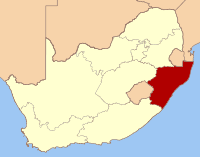
KwaZulu-Natal wine
Encyclopedia

KwaZulu-Natal is designated as a Geographical Unit under the Wine of Origin classification of South African wine
South African wine
South African wine has a history dating back to 1659, and at one time Constantia was considered one of the greatest wines in the world. Access to international markets has unleashed a burst of new energy and new investment. Production is concentrated around Cape Town, with major vineyard and...
. It corresponds to the province of KwaZulu-Natal
KwaZulu-Natal
KwaZulu-Natal is a province of South Africa. Prior to 1994, the territory now known as KwaZulu-Natal was made up of the province of Natal and the homeland of KwaZulu....
in the east of South Africa, which has an embryonic wine industry.
Style
Sauvignon Blanc has been among the first to show promise in the Midlands of KwaZulu-Natal. However Pinotage and Pinot Noir are also doing extremely well due to the cool climate, as is Chardonnay. It is anticipated that the region will potentially produce some of the countries best Method Champagnes, as the climate is very similar to the Champagne region of France.History
The first trials of Vitis viniferaVitis vinifera
Vitis vinifera is a species of Vitis, native to the Mediterranean region, central Europe, and southwestern Asia, from Morocco and Portugal north to southern Germany and east to northern Iran....
in KwaZulu-Natal were in 1992 at Sunwich Port.
Tiny and Judy van Niekerk set up the Stables Wine Estate in 2005.
Owners and winemakers Ian & Jane Smorthwaite bought their farm Abingdon Wine Estate in 2000 and the first vines were planted in 2004. Situated at 1100m above sea level, 'Abingdon Estate' has in excess of 2ha under vine and this includes the only certified single vineyard in the entire Kwa-Zulu Natal region.
Wine of Origin
In 2001, vineyards were planted in KZN in what was described as a "trial run" to investigate the plausibility of growing and making wine in the region.Approximately 4 000 vines were distributed among prospective growers in an experiment led by Dr Clive Kaiser, a horticulturalist for the KwaZulu-Natal Department of Agriculture at Cedara. Eleven participating farms were cited as growers and ambitions were of rural development projects, further expansion of vineyards and subsequent wine production. Success proved dismal, and under the guidance of Kaiser, new trial vines were established at Bracken, a farm in Greytown.In 2002, Rob Osbourne took over responsibilities from Dr Kaiser, continuing to promote the wine-growing industry in KZN with trial plantings of grapes in various pockets scattered across the Midlands. The possibility of establishing KZN as a wine-growing region attracted other interested parties to the Midlands who individually started to explore the viability of making and producing wine in a former non-demarcated Wine of Origin region. In 2010 there are a handful of growers in KZN, but two producers are recognised as major players: Abingdon Wine Estate and The Stables Wine Estate.
KwaZulu-Natal was designated as a Wine of Origin under the classification scheme of South African wine
South African wine
South African wine has a history dating back to 1659, and at one time Constantia was considered one of the greatest wines in the world. Access to international markets has unleashed a burst of new energy and new investment. Production is concentrated around Cape Town, with major vineyard and...
in August 2005. The first ever KwaZulu-Natal Wine of Origin wine was released by The Stables Wine Estate on 28 July 2006.
It has, however, been confirmed that The Stables indeed hasn't always made use of locally sourced grapes (even though labels in their range might suggest otherwise). Stellenbosch winemakers, whose names are known to WINE MAGAZINE, confirm that wines - Rosé, Chenin, Tawny Port, Cabernet Sauvignon, Merlot, Shiraz, Chardonnay, Sauvignon Blanc - were sold in bulk to The Stables in 2006 and 2007. Some of the varietals were made into the red blend ‘The Time Is Now' released by Judy and Tiny to commemorate the Rugby World Cup in 2007. Although Tiny takes credit for making this wine (which was also awarded a Bronze Veritas medal), the Veritas office quotes a different wine farm as producer. (Tiny also confirms that they did buy in wine from the Western Cape during the farm's start-up years.
Geography
Altitude in the KwaZulu-Natal Midlands seems to be the key to getting good results - the climate is similar to Burgundy and Champagne.However more plantings along the North Coast of Ballito will offer very different results with a cultivar that is being imported from Brazil, Villard Blanc.
External links
- www.stableswine.co.za
- www.winemag.co.za WINE magazine
- www.abingdonestate.co.za

